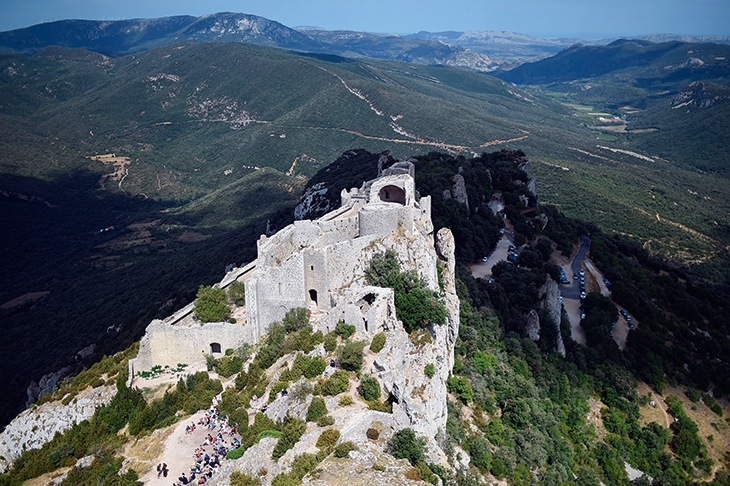I once spent three months living in the Languedoc, writing my first novel. The highlight was the few days I allowed myself away from my monastic schedule to visit Cathar country. I’d been dying to see it because the castles and the landscape are so stark and dramatic, the history is so dark, bloody and weird, and because I wanted to try cassoulet in its proper location.
I can’t remember much about the various cassoulets I tried except that, though it’s impossible to go wrong with goose, sausage and beans, none of them was quite as good as the one I laboriously recreated at home from a recipe in my Larousse Gastronomique. But you never forget the castles, such as Peyre-pertuse, jutting, as so many of them do, from a vertiginous, craggy, razor-back ridge. I clambered over it at dusk, after it had closed, and had it all to myself. The wind whistled (it was December) and it was so easy to imagine the ghosts of those who had lived and died there, many of them horribly.
The Cathars were a heretical sect who believed (probably correctly) that their Gnostic version of Christianity — simple, honest, virtuous — was truest to the original. Naturally, the Catholic Church hated them for this and tried to eradicate them in numerous purges, culminating in the Albigensian Crusade launched by Pope Innocent III. It was prosecuted with a savagery redolent of Isis’s persecution of the Yazidis in northern Iraq. When the crusaders reached Béziers, the Papal legate sent out a message to its Catholic citizens that they should hand over the leading Cathars and spare themselves. The citizens refused and every last one — as many as 20,000 — was slaughtered. Many burned alive in the cathedral. ‘Kill them all and let God sort them out,’ the legate infamously commanded.
Once it was all over and the last Cathars had been hanged, burned at the stake or driven into the wilds, the Catholic Church celebrated by building probably the world’s most magnificently ugly cathedral in Albi, thought to be the heresy’s centre. Wide and vast, with a turret-like belltower at one end, built from red brick, it wasn’t designed with beauty in mind: it was meant to be like a fortress, signalling to the local populace the total, crushing domination of the church. It’s horrible but I kind of love it — and the interior is much prettier than the exterior.
Finally Carcassonne, which inspired the world’s most addictive tile-centric strategy game (seriously: just get it!), and which is probably the closest you’ll ever get to experiencing the perfect fantasy medieval castle, with drawbridges, a moat, and turrets with conical roofs. You can imagine Rapunzel letting down her hair here — or Shrek climbing to meet Princess Fiona.
It’s all a sham, of course. Which is to say, it was heavily restored in the mid-19th century by the architect Eugène Viollet-le-Duc. But it’s still gorgeously romantic, though best visited outside the main tourist season — I went at Christmas, when the weather was so warm you rarely needed more than a T-shirt — because being a Unesco world heritage site, it does get awfully crowded. Book a table in one of the many good restaurants within its walls. Lunch is the perfect time for cassoulet: you need time to walk off all that unctuous grease, stodge and deliciousness.







Comments